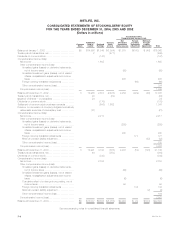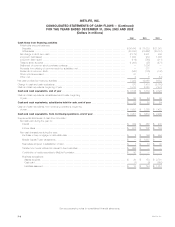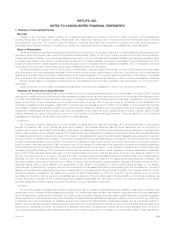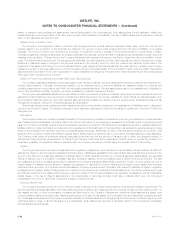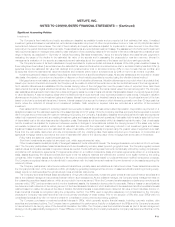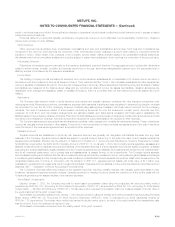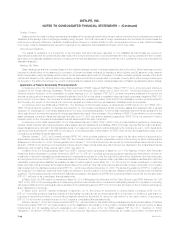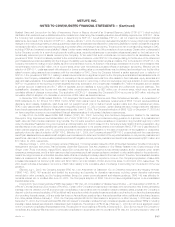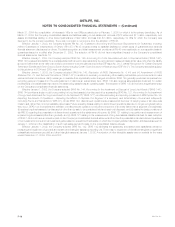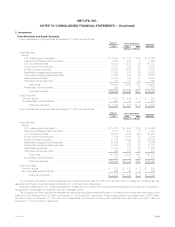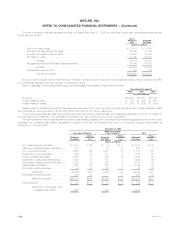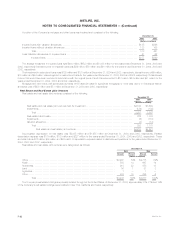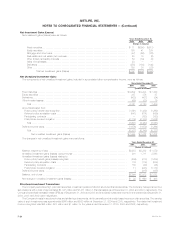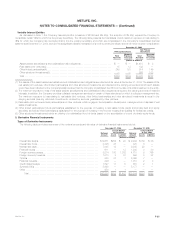MetLife 2004 Annual Report Download - page 58
Download and view the complete annual report
Please find page 58 of the 2004 MetLife annual report below. You can navigate through the pages in the report by either clicking on the pages listed below, or by using the keyword search tool below to find specific information within the annual report.METLIFE, INC.
NOTES TO CONSOLIDATED FINANCIAL STATEMENTS — (Continued)
period in which services are provided. Amounts that are charged to operations include interest credited and benefit claims incurred in excess of related
policyholder account balances.
Premiums related to property and casualty contracts are recognized as revenue on a pro rata basis over the applicable contract term. Unearned
premiums are included in other liabilities.
Other Revenues
Other revenues include advisory fees, broker/dealer commissions and fees, and administrative service fees. Such fees and commissions are
recognized in the period in which services are performed. Other revenues also include changes in account value relating to corporate-owned life
insurance (‘‘COLI’’). Under certain COLI contracts, if the Company reports certain unlikely adverse results in its consolidated financial statements,
withdrawals would not be immediately available and would be subject to market value adjustment, which could result in a reduction of the account value.
Policyholder Dividends
Policyholder dividends are approved annually by the insurance subsidiaries’ boards of directors. The aggregate amount of policyholder dividends is
related to actual interest, mortality, morbidity and expense experience for the year, as well as management’s judgment as to the appropriate level of
statutory surplus to be retained by the insurance subsidiaries.
Income Taxes
The Holding Company and its includable life insurance and non-life insurance subsidiaries file a consolidated U.S. federal income tax return in
accordance with the provisions of the Internal Revenue Code of 1986, as amended (the ‘‘Code’’). Non-includable subsidiaries file either separate tax
returns or separate consolidated tax returns. The future tax consequences of temporary differences between financial reporting and tax bases of assets
and liabilities are measured at the balance sheet dates and are recorded as deferred income tax assets and liabilities. Valuation allowances are
established when management assesses, based on available information, that it is more likely than not that deferred income tax assets will not be
realized.
Reinsurance
The Company has reinsured certain of its life insurance and property and casualty insurance contracts with other insurance companies under
various agreements. Reinsurance premiums, commissions, expense reimbursements, benefits and reserves related to reinsured long-duration contracts
are accounted for over the life of the underlying reinsured contracts using assumptions consistent with those used to account for the underlying
contracts. The cost of reinsurance related to short-duration contracts is accounted for over the reinsurance contract period. Amounts due from
reinsurers, for both short- and long-duration arrangements, are estimated based upon assumptions consistent with those used in establishing the
liabilities related to the underlying reinsured contracts. Policy and contract liabilities are reported gross of reinsurance credits. DAC is reduced by amounts
recovered under reinsurance contracts. Amounts received from reinsurers for policy administration are reported in other revenues.
The Company assumes and retrocedes financial reinsurance contracts, which represent low mortality risk reinsurance treaties. These contracts are
reported as deposits and are included in other assets. The amount of revenue reported on these contracts represents fees and the cost of insurance
under the terms of the reinsurance agreement and is reported in other revenues.
Separate Accounts
Separate accounts are established in conformity with insurance laws and are generally not chargeable with liabilities that arise from any other
business of the Company. Separate account assets are subject to general account claims only to the extent the value of such assets exceeds the
separate account liabilities. Effective with the adoption of Statement of Position 03-1, Accounting and Reporting by Insurance Enterprises for Certain
Nontraditional Long-Duration Contracts and for Separate Accounts (‘‘SOP 03-1’’), on January 1, 2004, the Company reports separately, as assets and
liabilities, investments held in separate accounts and liabilities of the separate accounts if (i) such separate accounts are legally recognized; (ii) assets
supporting the contract liabilities are legally insulated from the Company’s general account liabilities; (iii) investments are directed by the contractholder;
and (iv) all investment performance, net of contact fees and assessments, is passed through to the contractholder. The Company reports separate
account assets meeting such criteria at their fair value. Investment performance (including investment income, net investment gains (losses) and changes
in unrealized gains (losses)) and the corresponding amounts credited to contractholders of such separate accounts are offset within the same line in the
consolidated statements of income. In connection with the adoption of SOP 03-1, separate account assets with a fair value of $1.7 billion were
reclassified to general account investments with a corresponding transfer of separate account liabilities to future policy benefits and policyholder account
balances. See ‘‘— Application of Recent Accounting Pronouncements.’’
The Company’s revenues reflect fees charged to the separate accounts, including mortality charges, risk charges, policy administration fees,
investment management fees and surrender charges. Separate accounts not meeting the above criteria are combined on a line-by-line basis with the
Company’s general account assets, liabilities, revenues and expenses.
Stock-Based Compensation
Effective January 1, 2003, the Company accounts for stock-based compensation plans using the prospective fair value accounting method
prescribed by SFAS No. 123, Accounting for Stock-Based Compensation (‘‘SFAS 123’’), as amended by SFAS No. 148, Accounting for Stock-Based
Compensation — Transition and Disclosure (‘‘SFAS 148’’). The fair value method requires compensation cost to be measured based on the fair value of
the equity instrument at the grant or award date.
Stock-based compensation grants prior to January 1, 2003 are accounted for using the intrinsic value method prescribed by Accounting Principles
Board Opinion (‘‘APB’’) No. 25, Accounting for Stock Issued to Employees (‘‘APB 25’’). Note 12 includes the pro forma disclosures required by
SFAS No. 123, as amended. The intrinsic value method represents the quoted market price or fair value of the equity award at the measurement date
less the amount, if any, the employee is required to pay.
Stock-based compensation is accrued over the vesting period of the grant or award.
MetLife, Inc. F-15



